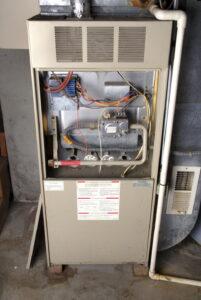Ever had one of those traveling thoughts about carbon monoxide after watching a horror movie or a true crime documentary? Sometimes this can be common when sitting home alone and hearing the gentle “hum” of the furnace as it keeps your whole home warm.
Is the furnace truly your friend and keeping you cozy? Or is it a dangerous machine that could turn your life into a true-crime documentary at any moment?
Well, the answer is no–your furnace is not a dangerous machine. It’s built with a lot of failsafe systems and components that are specifically there to keep you safe, which we’ll get into down below.
But furnaces in Hunterdon County can become unsafe due to unsafe practices and neglect over the years. So be sure to follow up with us after reading this blog post and invest in yearly maintenance to ensure your furnace stays safe and secure.
Mercaptan and Your Furnace’s Flame Sensor
If you’ve ever wondered whether gas would start to leak into your home through your furnace, then we’d like to introduce you to two things that make sure that doesn’t happen.
First, all of the natural gas that flows into your home is mixed with a chemical called mercaptan, which is responsible for giving it that noticeable “rotten egg” smell. This is important because it makes it very easy for your nose to pick up when gas does start leaking from the system.
And another component that’s constantly protecting you is the “flame sensor,” sometimes called the “heat sensor.” It detects when gas starts flowing into the combustion chamber to be burned for heat.
If the gas isn’t being burned, and is leaking or just flowing wastefully through the system, the flame sensor will detect this and shut the gas lines down, stopping the flow of gas into your home and keeping you safe.
Don’t Forget About the Heat Exchanger
The heat exchanger is another component that stands vigilantly in the way of any dangerous fumes. When gas is burned and fumes like carbon monoxide are created, they are vented out through the port exhaust.
In order for those fumes not to accidentally mix with the fresh air of your home, the heat exchanger stands there and separates the two sets of air. Heat is exchanged from the combustion chamber to the fresh air of your home, and the fumes are jettisoned out!
The Carbon Monoxide Detector
And, just remember that your home is also protected from a carbon monoxide leak with the help of carbon monoxide detectors placed in strategic locations! These units will alert you to any CO leaks that might be happening under your nose, as an added layer of protection for you and your family.
Invest in Maintenance and Repairs
The truth is that any of these components can run into problems, even if it is exceedingly rare during the lifespan of the system. It’s up to you to invest in maintenance and repairs to ensure that your furnace keeps running safely and efficiently.
For any additional questions or concerns, contact Schaible’s Plumbing & Heating Inc. We’re here to help!

